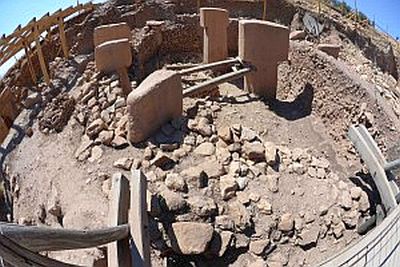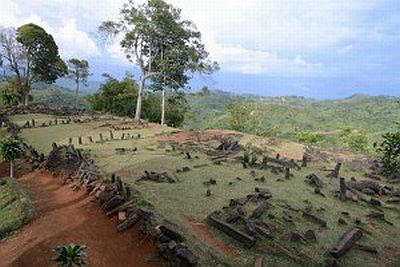“Could [Gobekli Tepe] be the fabled “Hall of Records” of Atlantis? If Dr. Natawidjaja’s geological excavation is allowed to proceed, despite strenuous attempts by local archaeologists to prevent it, then we should know the answer to that question, one way or another, by the end of 2014.” G Hancock

“Everything we’ve been taught about the origins of civilization may be wrong”, says Danny Natawidjaja, PhD, senior geologist with the Research Centre for Geotechnology at the Indonesian Institute of Sciences. “Old stories about Atlantis and other a great lost civilizations of prehistory, long dismissed as myths by archaeologists, look set to be proved true”.
From Indonesia to Turkey
I’m climbing with Dr Natawidjaja up the steep slope of a 300-ft high step-pyramid set amidst a magical landscape of volcanoes, mountains and jungles interspersed with paddy fields and tea plantations a hundred miles from the city of Bandung in West Java, Indonesia.
The pyramid has been known to archaeology since 1914 when megalithic structures formed from blocks of columnar basalt were found scattered amongst the dense trees and undergrowth that then covered its summit. Local people held the site to be sacred and called it Gunung Padang, the name it still goes by today, which means “Mountain of Light”, or “Mountain of Enlightenment”, in the local Sundanese language. The summit, where the megaliths were found arranged across five terraces had been used as a place of meditation and retreat since time immemorial, archaeologists were told, and again this remains true today.
However neither the archaeologists, nor apparently the locals realized the pyramid was a pyramid. It was believed to be a natural hill, somewhat modified by human activity, until Natawidjaja and his team began a geological survey here in 2011. By then the summit had long since been cleared and the megalithic terraces recognized to be ancient and man-made, but no radiocarbon dating was ever done and the previously accepted age of the site – about 1,500 to 2,500 BC — was based on guesswork rather than on excavations.
The first scientific radiocarbon dating was done by Natawidjaja himself on soils underlying the megaliths at or near the surface. The dates produced – around 500 to 1,500 BC – were very close to the archaeological guesswork and caused no controversy. However a surprise was in store as Natawidjaja and his team extended their investigation using tubular drills that brought up cores of earth and stone from much deeper levels.
First the drill cores contained evidence – fragments of columnar basalt – that man-made megalithic structures lay far beneath the surface. Secondly the organic materials brought up in the drill cores began to yield older and older dates – 3,000 BC to 5,000 BC, then 9,600 BC as the drills bit deeper, then around 11,000 BC, then, 15,000 BC and finally at depths of 90 feet and more an astonishing sequence of dates of 20,000 BC to 22,000 BC and earlier.

“This was not at all what my colleagues in the world of archaeology expected or wanted to hear” says Natawidjaja, who earned his PhD at Cal Tech in the United States and who, it becomes apparent, regards archaeology as a thoroughly unscientific discipline.
The problem is that those dates from 9,600 BC and earlier belong to the period that archaeologists call the “Upper Palaeolithic” and take us back deep into the last Ice Age when Indonesia was not a series of islands as it is today but was part of a vast southeast Asian continent dubbed “Sundaland” by geologists.
Sea level was 400 feet lower then because huge ice caps two miles deep covered most of Europe and North America. But as the ice caps began to melt all the water stored in them returned to the oceans and sea-level rose, submerging many parts of the world where humans had previously lived. Thus Britain was joined to Europe during the Ice Age (there was no English Channel or North Sea). Likewise there was no Red Sea, no Persian Gulf, Sri Lanka was joined to southern India, Siberia was joined to Alaska, Australia was joined to New Guinea – and so on and so forth. It was during this epoch of sea-level rise, sometimes slow and continuous, sometimes rapid and cataclysmic, that the Ice Age continent of Sundaland was submerged with only the Malaysian Peninsula and the Indonesian islands as we know them today high enough to remain above water.
The established archaeological view of the state of human civilization until the end of the last Ice Age about 9,600 BC was that our ancestors were primitive hunter gatherers incapable of any form of civilization or architectural feats. In the following millennia settled agriculture was very gradually developed and perfected. Around 4,000 BC the increasing sophistication of economic and social structures, and growing organizational abilities, made possible the creation of the earliest megalithic sites (such as Gigantija on the Maltese island of Gozo for example) while the first true cities emerged around 3500 BC in Mesopotamia and soon afterwards in Egypt. In the British Isles Callanish in the Outer Hebrides and Avebury in southwest England, both dated to around 3,000 BC, are the oldest examples of true megalithic sites. The megalithic phase of Stonehenge is thought to have begun around 2,400 BC and to have continued to around 1,800 BC.

Thanks for this fantastic article.
How exciting! The lost city of Atlantis.
So strange I was literally reading a book last night which is claimed to have been written by an Atlantean – Thoth. Amazing book. He wrote about the flood and that there are serpent beings which inhabit the world, brought forth by inhabitants of the earth from before his time. He advises always focusing on the light.